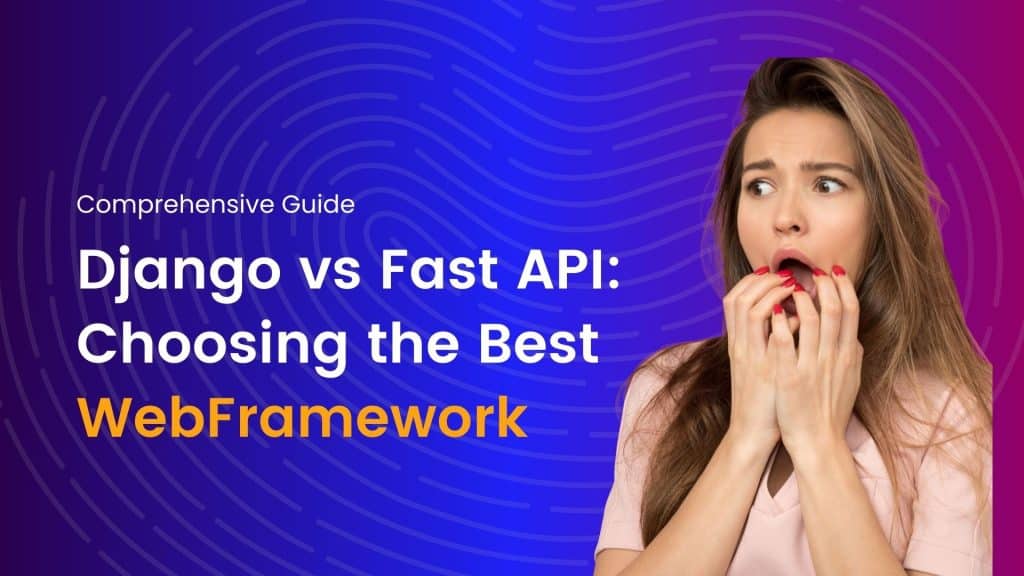Python, a versatile and powerful programming language, is widely used for web development. When it comes to choosing a web framework, developers often find themselves torn between two prominent options: Django and FastAPI. Each framework has its strengths and weaknesses, making the decision a nuanced one. In this article, we will delve into the features, performance, and use cases of Django and FastAPI to help you make an informed decision based on your project requirements.
Django
Django is a high-level, full-stack web framework that follows the “batteries-included” philosophy. Developed with a focus on simplicity, productivity, and reusability, Django provides a robust and well-organized structure for building web applications. It comes with an ORM (Object-Relational Mapping) system, an admin interface, and built-in security features, making it an excellent choice for large-scale projects with tight deadlines.
Key Features of Django
Django, a high-level web framework written in Python, has gained immense popularity for its simplicity, flexibility, and efficiency in building robust web applications. Developed with the “don’t repeat yourself” (DRY) principle in mind, Django emphasizes rapid development and clean, maintainable code. In this article, we’ll explore the key features that make Django an exceptional choice for web developers.
Model-View-Controller (MVC) Architecture
Django follows the Model-View-Controller (MVC) architectural pattern, known in Django as Model-View-Template (MVT). This separation of concerns promotes modular development, making it easier to manage and scale applications. Models define the data structure, views handle the presentation logic, and templates manage the user interface.
Object-Relational Mapping (ORM)
Django provides a powerful ORM system that abstracts database interactions, allowing developers to interact with databases using Python code rather than SQL queries. This simplifies database operations, reduces the risk of SQL injection, and enhances code readability. Developers can switch between different database engines without changing the code, thanks to Django’s ORM.
Admin Interface
One of Django’s standout features is its built-in admin interface. With just a few lines of code, developers can create a fully functional administration panel for managing database records. This feature is a time-saver during the development phase and provides a user-friendly interface for non-technical personnel to manage data.
Automatic URL Routing
Django’s URL routing system simplifies the process of handling URL patterns and mapping them to appropriate views. By using regular expressions and a straightforward URL configuration, developers can easily define how URLs are processed and direct users to the desired content.
Built-in Security Features
Django prioritizes security and includes several built-in features to protect against common web vulnerabilities. This includes protection against Cross-Site Scripting (XSS), Cross-Site Request Forgery (CSRF), SQL injection, and more. Django’s security features help developers adhere to best practices without additional effort.
Template Engine
Django comes with a template engine that allows developers to create dynamic and reusable HTML templates. This separation of HTML from Python code enhances code readability and maintainability. Templates support template inheritance, filters, and tags, providing flexibility in designing web pages.
Middleware Support
Middleware components in Django allow developers to process requests and responses globally, enabling functionalities such as authentication, caching, and security checks. This extensibility simplifies the addition of custom functionalities to the application’s request-response cycle.
Scalability and Reusability
Django’s modular design and adherence to best practices contribute to the scalability and reusability of code. Developers can create reusable apps, facilitating the sharing of components across different projects. This promotes a collaborative development environment and accelerates project timelines.
Django REST Framework
For building RESTful APIs, Django provides the Django REST framework. This powerful toolkit simplifies API development, supporting features such as serialization, authentication, and viewsets. It is a popular choice for developing APIs in conjunction with Django web applications.
Community and Documentation
Django boasts a vibrant and supportive community, making it easier for developers to seek help, share knowledge, and collaborate on projects. The extensive documentation provides detailed guides, tutorials, and examples, making it accessible for both beginners and experienced developers.
FastAPI
FastAPI is a modern, asynchronous web framework designed for building APIs quickly and efficiently. Leveraging Python type hints, FastAPI allows developers to benefit from automatic data validation and documentation generation. Its asynchronous nature and performance optimizations make it an excellent choice for projects where speed and scalability are crucial.
Key Features of Fast API
In the ever-evolving landscape of web development, choosing the right framework can significantly impact a project’s success. FastAPI, a modern and fast Python web framework, has gained considerable attention for its performance, simplicity, and automatic OpenAPI and JSON Schema generation. In this article, we will delve into the key features that make FastAPI a compelling choice for developers.
Fast and Asynchronous
FastAPI lives up to its name by being one of the fastest web frameworks for building APIs in Python. It leverages asynchronous programming, using Python’s async and await syntax, allowing developers to write efficient and scalable code. Asynchronous I/O operations enable the server to handle multiple requests simultaneously, enhancing performance and responsiveness.
Automatic Documentation
One standout feature of FastAPI is its automatic generation of interactive documentation. Utilizing the OpenAPI standard and JSON Schema, FastAPI creates comprehensive and user-friendly documentation for your API without the need for additional tools. This not only saves development time but also ensures that the documentation is always up-to-date as the code evolves.
Data Validation and Serialization
FastAPI simplifies the process of data validation and serialization by using Python type hints. By annotating function parameters and request bodies with specific types, FastAPI automatically validates incoming data and generates appropriate error responses. This not only improves code readability but also enhances the overall reliability of the application.
Dependency Injection System
FastAPI employs a powerful dependency injection system, making it easy to manage and organize code. Dependencies, such as database connections or authentication checks, can be injected into route functions, enhancing code modularity and testability. This feature contributes to the overall maintainability of the application.
Security Features
Security is a top priority in web development, and FastAPI provides built-in features to address common security concerns. It includes automatic generation of secure API documentation, input validation to prevent data injection attacks, and support for OAuth2 and JWT authentication. Developers can focus on building features rather than worrying about security loopholes.
WebSockets Support
FastAPI supports WebSocket communication, allowing real-time bidirectional communication between clients and servers. This is particularly useful for applications that require instant updates, such as chat applications, live notifications, or collaborative editing tools. FastAPI’s WebSocket support simplifies the implementation of these features.
Compatibility with Starlette and ASGI
FastAPI is built on top of the Starlette framework and is designed to be compatible with the ASGI (Asynchronous Server Gateway Interface) standard. This ensures flexibility and interoperability with other ASGI-compatible tools and middleware, providing developers with a wide range of options for building and extending their applications.
Intuitive API Declaration
FastAPI promotes a declarative style for API development. With minimal code, developers can define API routes, request and response models, and dependencies. This simplicity, combined with automatic documentation generation, accelerates the development process and reduces the likelihood of errors.
Choosing the Right Framework
Choosing between Django and FastAPI depends on various factors, including the nature of your project, development goals, and specific requirements. Let’s break down the decision-making process to help you make an informed choice between these two Python web frameworks.
Project Nature and Complexity
- Django:
- Strengths: Well-suited for large-scale applications with complex data structures and extensive features. The built-in admin interface simplifies content management and data operations.
- Use Cases: Content management systems, e-commerce platforms, and projects with a monolithic architecture.
- FastAPI:
- Strengths: Excelling in lightweight, high-performance APIs and asynchronous scenarios. Ideal for projects where speed and scalability are critical.
- Use Cases: API development, microservices architecture, and real-time applications with WebSocket support.
Performance Requirements
Django
Strengths: Performs well for traditional web applications. Django’s synchronous nature may not be as performant in highly concurrent and real-time scenarios.
Considerations: Suitable for applications where high concurrency and real-time responsiveness are not primary concerns.
FastAPI
Strengths: Designed for high-performance asynchronous programming. Well-suited for real-time applications and scenarios with a large number of concurrent connections.
Considerations: Ideal for projects with a focus on speed, scalability, and responsiveness.
Learning Curve
Django
Strengths: Beginner-friendly with extensive documentation and a large, supportive community. Follows the MVC (Model-View-Controller) architectural pattern.
Considerations: Great for teams with varying levels of experience, especially those new to web development.
FastAPI
Strengths: Simplicity and reliance on Python type hints contribute to a gentle learning curve. Follows a more modern approach with automatic OpenAPI documentation.
Considerations: Suitable for developers familiar with asynchronous programming and modern web development concepts.
Community and Ecosystem
Django
Strengths: Boasts a mature ecosystem with a vast array of third-party packages and a well-established community.
Considerations: Ideal for projects that benefit from a rich selection of existing tools and plugins.
FastAPI
Strengths: A growing community with a focus on performance and modern web development. Increasing popularity with an emphasis on simplicity and speed.
Considerations: Suitable for projects that value a more modern and performance-centric approach, even if the ecosystem is still expanding.
Decision Criteria
Choose Django if
-
- You need an all-in-one solution for large-scale applications.
- The project requires a comprehensive admin interface for data management.
- A mature ecosystem with extensive third-party support is crucial.
Choose FastAPI if
-
- Your primary focus is on building high-performance APIs or real-time applications.
- Asynchronous programming is a requirement for your project.
- You value automatic API documentation and simplicity in development.
Conclusion
Both Django and FastAPI have their merits and cater to different needs in the web development landscape. Django is a robust framework suitable for a wide range of projects, especially those that benefit from its batteries-included approach. On the other hand, FastAPI shines when it comes to performance and is an excellent choice for building APIs with modern Python features.
Consider the specific requirements and constraints of your project, and weigh the pros and cons of each framework before making a decision. Ultimately, both Django and FastAPI are powerful tools that can empower developers to create successful web applications in Python.
FastAPI has quickly become a favorite among Python developers for building APIs due to its exceptional performance, automatic documentation, and developer-friendly features. Whether you are working on a small project or a large-scale application, FastAPI provides the tools you need to create robust and efficient APIs. As the web development landscape continues to evolve, FastAPI is positioned to play a significant role in shaping the future of Python-based API development.
I'm a tech-savvy writer with a Computer Science degree and web hosting background, contributing to Hostao Blogs. I simplify complex tech topics like web development and cybersecurity. Beyond writing, I'm a tech explorer passionate about digital advancements.



















